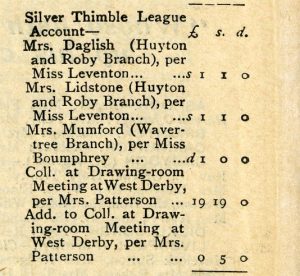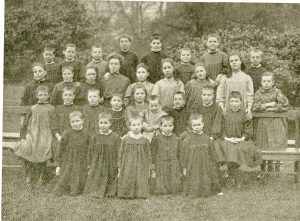Another in the series of our blogs that takes a look at the history of raising money for The Children’s Society’s.The following article – written by one of our volunteers, Rod Cooper – is the second of two articles focusing on the local fundraising efforts undertaken within a local branch – namely, the Liverpool Branch – of the Waifs and Strays Society in the early years of the twentieth century. In particular, the article looks at the activities of a locally organised initiative – The Silver Thimble League.
Founded in 1897 by Mrs George Killey – the wife of the Diocesan Chairman – the Silver Thimble League was in essence a development on the theme of Sales of Work, though on a much grander and organised scale. Established on a branch by branch basis, members of the League would prepare items for sale, primarily at a single, large-scale, event held over a number of days at a well-known, centrally based venue. In May 1905, the event was held over three days at the Hardman Street Assembly Rooms in central Liverpool. At this time, there were about 1,500 members in the League, and in planning for that year’s sale, all were implored to “kindly work very hard [. . .] as we aim at making £1,000” (Our Waifs and Strays Magazine (OWS), March 1905). This was a huge and ambitious sum – in excess of £100,000 by today’s value – and considerably more than the £833 sum achieved the year previously.
Opened by the Lord Mayor of Liverpool, The Silver Thimble League sale opened on 4 May, and featured stalls representing many local branches of the Waifs and Strays Society, including those for Seaforth and District, Waterloo and Crosby, Sefton Park and Huyton and Roby, among many others. Opened on successive days by Lady Forwood and then by Mrs Fleetwood – the Lady President of the Seaforth Home Committee – the event featured a full roster of attractions for visitors, including the sale of refreshments, various competitions, and music recitals by ensembles such as the Cairngorm Orchestra and the Sefton Ladies Orchestra. Though very much the main event, there were a number of smaller sales staged by the League elsewhere and there were, for example, additional events organised at Warrington, Blundellsands and Maghull.
Although hopes were high, and “the means of relieving us of our pressing financial difficulties” (OWS, April 1905), the revenues generated by The Silver Thimble League proved somewhat disappointing. After a deduction for expenses amounting to just under one hundred pounds, the amount raised for charitable purposes was just under £800; still a phenomenal amount for local fund-raising (the modern equivalent of £88,000), though short by about £60 than the sum raised in 1904: “It gives us no cause for discouragement, but rather spurs us on to see that the 1906 Sale fully compensates for any slight diminution.” (OWS, December 1905). In spite of these disappointments, the Silver Thimble League would continue to produce substantial funds for the local branch for years to come. Moreover, it proved to be such an effective model for fund-raising that a nationwide initiative – the Golden Thimble League – would be established in the 1930s.
An unusual aspect of The Silver Thimble League, and one that would appear counter to centralised coordination of financial planning within the Diocese, was that its accounts at this time were operated independently from the Diocese’s own. It is difficult to speculate how this all worked out on a practical level, though it is hard to construe that this was an optimal arrangement. As it was, the sources from 1905/06 show The Silver Thimble League allocating funds directly to various organisations within the Diocese, including all four homes, the Bradstock Lockett Building Fund (£60), the Children’s Union (Northern Province) (£60), and the Deficit Reduction Account (£136). An amount in respect of Office Staff (£15, 5s.) was also itemised.
The Society’s homes too, were a source of income. From a modern perspective this might appear somewhat controversial, and particularly so as it was one home in particular – the girls’ home at Scholfield, Wavertree – that far and away provided the most revenue. The lists of donations for this period do show a small sum (£3.25) being donated in respect of “Boys wages at St George’s Home (OWS June 1905), but this pales into insignificance when compared to the annual sum of almost £146 listed under “Laundry Receipts at Scholfield Home”. The income generated at Scholfield was regular, and though the amounts might have varied from month to month, it was clearly an established activity. Indeed, in “Notes From the North” (OWS March 1906) it is declared that, “We can do more laundry work at Scholfield Home; the work is well done and the greatest care exercised. We could do with one or two families’ work, and we can guarantee efficiency, courtesy, exactitude in return, and moderate charges. Ladies, do help us to help ourselves!” By today’s standards this might be considered exploitative, whereas at the time it would have been probably viewed as a worthy and justifiable exercise in self-help and self-sufficiency. It would be misplaced too, to think that the boys at St George’s and Elm Lodge were let off relatively lightly; many children in The Society’s homes at this time were expected to undertake work within in the homes themselves, to make items for Sales of Work, and to participate in activities within their local communities.
Bolstering these various sources of funding were numerous individual donations. Occasionally these would be regular – for example, each year the sum of £10 was received from “A Friend in India” for the express purpose of supporting “Christmases and other Festivities” in The Society’s homes. The majority of individual donations, however, tended to be rather more irregular and one-off. For example, these might include £8 for the “Sale of a Pony” (OWS December 1905); or could be huge sums such as £78 15 shillings and 2 pence representing the “Part proceeds of Entertainment at Southport, per the Countess of Latham,” or a mere 6 shillings and 6 pence (about 32p) from the sale of Mrs Hacking’s marmalade (both OWS October 1905). Perhaps the final word in grass roots fund-raising for this particular period should refer back to where we started in the first article and the joint efforts of Irene Johnson and Nellie Shaw. Emboldened by their efforts earlier during the year, and “stimulated by their past success, they have held another Sale, and have just sent us £3 3s. [£3.15]. Now, girls and boys, is that not splendid?” (OWS January 1906)

Our Waifs and Stray, December 1905, page 180 – a close up of a contribution list – showing Silver Thimble League receipts at the Schofield Home.
Unfortunately, the efforts of Irene and Nellie and many hundreds of other donors and supporters were not nearly splendid enough. As the Liverpool Branch entered the New Year, the Committee were indeed optimistic towards the future: “With the close of the year we have reason to think, with feelings of deep gratitude, that our income has covered the cost of maintaining our four Diocesan Homes and our boarded-out children, in all a family of about 200; and possibly, we venture to hope, when the balance is struck, we may have been fortunate enough to reduce, in however small a degree, the accumulated deficit, which has pressed so heavily upon us.” (OWS Feb 1906). Such hopes were misplaced however, and the deficit had increased to £565 19s 5d; and increase of £56, or 11% over the previous year’s figure – a significant increase and an accumulated debt equivalent to £63,000 at today’s value.
Reducing the accumulated debt would trouble the Liverpool Branch for many years to come, and it would be fair to say that operating with a debit balance became quite the norm. There were a handful of occasions when it was able to report a small credit balance (it was £32 to the good in 1914, for example), but even as late as the mid-1920s the Branch was reporting an annual debt of almost £380. It would be a mistake, however, to portray this as a problem specific to the Liverpool Diocese alone; it being fairer to comment that the situation in Liverpool was a reflection of The Waifs and Strays state of financial affairs in general. In 1907, for example, Edward Rudolf – founder and Secretary of The Society – made a number of pleas for funds, and referred readers of Our Waifs and Strays to a deficit of £8,500 on the general fund – almost £1 million at today’s values. (OWS June 1907)
With the passing of time, the level of financial detail reported in Our Waifs and Strays for the Liverpool Diocese diminished, and it is noticeable that – instead of hard facts and figures – terms such as “small credit balance” and “improved financial position” become more apparent. This is not to say that the Branch became more relaxed about this state of affairs, but in as much as the incoming funds varied over the short-term, there was the guarantee of strong and local grass roots support for The Society and the Liverpool homes, and with well-directed fund-raising campaigns and the network of parishes and congregations, the Liverpool Branch could rest in the knowledge that local fund-raising would meet much of the lion’s share of the finance needed to maintain its local needs.
Scanned copies of the Our Waifs and Strays magazine can be found here: http://www.hiddenlives.org.uk/publications/waifs_and_strays/index.html
Scanned copies of the Brothers and Sisters magazine can be found here: http://www.hiddenlives.org.uk/publications/brothers_and_sisters/index.html
Records featured in this blog are held at The Children’s Society Archive:
- for information about The Children’s Society Archive’s ‘Hidden Lives Revealed’ web site: http://www.hiddenlives.org.uk/
- or you can consult the Archive’s on-line catalogue: http://www.calmview.eu/childrensociety/Calmview/
If you would would like to know about how The Children’s Society continues to change children’s lives today, visit the charity’s website: http://www.childrenssociety.org.uk/
© The Children’s Society


